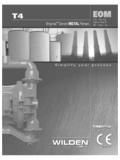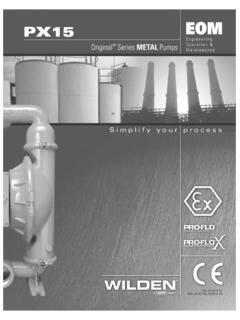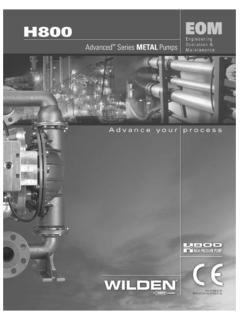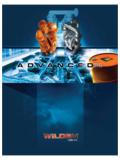Transcription of T8 - Wilden Pumps
1 Simplify your processEngineering Operation &MaintenanceOriginal series METAL PumpsT8 WIL-10272-E-01 Class I & II OzoneDepleting Clean Air ActAmendments of 1990 TABLE OF CONTENTSSECTION 1 CAUTIONS READ FIRST! ..1 SECTION 2 Wilden PUMP DESIGNATION SYSTEM ..2 SECTION 3 HOW IT WORKS PUMP & AIR DISTRIBUTION SYSTEM ..3 SECTION 4 DIMENSIONAL DRAWINGS ..4 SECTION 5 PERFORMANCEA. T8 Metal Performance CurvesRubber-Fitted ..6 TPE-Fitted ..6 PTFE-Fitted ..7 Stallion Ultra-FlexTM-Fitted ..7 Stallion TPE-Fitted ..8B. Suction Lift Curves ..9 SECTION 6 SUGGESTED INSTALLATION, OPERATION & TROUBLESHOOTING .. 10 SECTION 7 DISASSEMBLY / REASSEMBLY .. 13 Air Valve/Center Section Repair/Maintenance .. 16 Reassembly Hints & Tips.
2 18 Gasket Installation .. 18 SECTION 8 EXPLODED VIEW AND PARTS LISTINGT8 Metal Rubber/TPE-Fitted ..20T8 Metal PTFE-Fitted ..24 SECTION 9 ELASTOMER OPTIONS ..26 WIL-10272-E-01 1 Wilden PUMP & ENGINEERING, LLCTEMPERATURE LIMITS: Neoprene C to C 0 F to 200 F Buna-N C to C 10 F to 180 F EPDM C to C 60 F to 280 F Viton 40 C to C 40 F to 350 F Wil-Flex 40 C to C 40 F to 225 F Polyurethane C to C 10 F to 150 F Saniflex C to C 20 F to 220 F PTFE C to C 40 F to 220 F Fluoro-Seal 40 C to 232 C 40 F to 450 FCAUTION: When choosing pump materials, be sure to check the temperature limits for all wetted compo-nents. Example: Viton has a maximum limit of C (350 F) but polypropylene has a maximum limit of only 79 C (175 F).
3 CAUTION: Maximum temperature limits are based upon mechanical stress only. Certain chemicals will significantly reduce maximum safe operating tempera-tures. Consult engineering guide for chemical compat-ibility and temperature : Always wear safety glasses when operat-ing pump. When diaphragm rupture occurs, material being pumped may be forced out air : Prevention of static sparking If static sparking occurs, fire or explosion could result. Pump, valves, and containers must be properly grounded when handling flammable fluids and whenever discharge of static electricity is a hazard. CAUTION: Do not exceed bar (125 psig) air supply pressure. ( bar [50 psig] on UL models.)CAUTION: Before any maintenance or repair is attempted, the compressed air line to the pump should be disconnected and all air pressure allowed to bleed from pump.
4 Disconnect all intake, discharge and air lines. Drain the pump by turning it upside down and allowing any fluid to flow into a suitable container. CAUTION: Blow out air line for 10 to 20 seconds before attaching to pump to make sure all pipe line debris is clear. Use an in-line air filter. A 5 (micron) air filter is : When installing PTFE diaphragms, it is impor-tant to tighten outer pistons simultaneously (turning in opposite directions) to ensure tight : Tighten all clamp bands and retainers prior to installation. Fittings may loosen during : Before starting disassembly, mark a line from each liquid chamber to its corresponding air chamber. This line will assist in proper alignment during : Verify the chemical compatibility of the process and cleaning fluid to the pump s component materials in the Chemical Resistance Guide (see E4).
5 CAUTION: When removing the end cap using compressed air, the air valve end cap may come out with considerable force. Hand protection such as a padded glove or rag should be used to capture the end cap. NOTE: All non lube-free air-operated Pumps must be lubricated. Wilden suggests an arctic 5 weight oil (ISO grade 15). Do not over-lubricate pump. Over-lubrica-tion will reduce pump : UL-listed Pumps must not exceed (50 psig) air supply : Only explosion proof (NEMA 7) solenoid valves should be used in areas where explosion proof equipment is required. Section 1 CAUTIONS READ FIRST! Wilden PUMP & ENGINEERING, LLC 2 WIL-10272-E-01 Section 2 PUMP DESIGNATION SYSTEMSPECIALTY CODESMATERIAL CODESLEGENDT8 X / XXXXX / XXX / XX / XXX /XXXXO-RINGSMODELVALVE SEATVALVE BALLSDIAPHRAGMSAIR VALVECENTER BLOCKAIR CHAMBERSWETTED PARTS & OUTER PISTONAIR SYSTEM BASE TYPESPECIALTYCODE(if applicable)
6 0051 Stallion , BSPT0052 Stallion , spark free0053 Stallion , footed, BSPT0054 Stallion , footed0055 Stallion , spark free, BSPT0112 Stallion , footed, spark free, without handles0113 Stallion , internals, spark free, BSPT0115 Stallion , footed, spark free, BSPT, without handles0116 Stallion , BSPT, without handles0117 Stallion , footed, BSPT, without handles0231 Stallion , externals (screen & handles)0233 Stallion , externals (screen & handles), BSPT0014 BSPT0030 Screen based0033 Screen based, spark free0036 Screen based, BSPT0037 Screen based, spark free, BSPT0039 Screen based, polyurethane screen0044 Stallion , balls & seats ONLY0045 Stallion , shaft & bumpers ONLY0046 Stallion , internals, BSPT0048 Stallion , internals0049 Stallion , aluminum screen base0050 Stallion Viton is a registered trademarks of DuPont Dow : MOST ELASTOMERIC MATERIALS USE COLORED DOTS FOR ORIGINAL METAL51 mm (2") Pump Maximum Flow Rate.
7 617 lpm (163 gpm)MODELT8 = 51 MM (2 )WETTED PARTS & OUTER PISTONAA = ALUMINUM / ALUMINUMWW = CAST IRON / CAST IRONAIR CHAMBERSA = ALUMINUMCENTER BLOCKA = ALUMINUMP = POLYPROPYLENE AIR VALVEB = BRASSDIAPHRAGMSBNS = BUNA-N (Red Dot)BNU = BUNA-N, ULTRA-FLEX EPS = EPDM (Blue Dot)EPU = EPDM, ULTRA-FLEX FSS = SANIFLEX [Hytrel (Cream)]NES = NEOPRENE (Green Dot)NEU = NEOPRENE, ULTRA-FLEX PUS = POLYURETHANE (Clear)TEU = PTFE W/EPDM BACK-UP (White)TNU = PTFE W/NEOPRENE BACK-UP (White)TSU = PTFE W/SANIFLEX BACK-UP (White)VTS = VITON (White Dot)VTU = VITON , ULTRA-FLEX WFS = WIL-FLEX [Santoprene (Orange Dot)]XBS = CONDUCTIVE BUNA-N (Two Red Dots)VALVE BALLBN = BUNA-N (Red Dot)FS = SANIFLEX [Hytrel (Cream)]FV = SANITARY VITON (Two White Dots)EP = EPDM (Blue Dot)NE = NEOPRENE (Green Dot)PU = POLYURETHANE (Brown)TF = PTFE (White)VT = VITON (White Dot)WF = WIL-FLEX [Santoprene (Orange Dot)]VALVE SEATA = ALUMINUM*BN = BUNA-N (Red Dot)EP = EPDM (Blue Dot)FS = SANIFLEX [Hytrel (Cream)]H = ALLOY C*M = MILD STEEL*NE = NEOPRENE (Green Dot)
8 PU = POLYURETHANE (Clear)S = STAINLESS STEEL*VT = VITON (White Dot)WF = WIL-FLEX [Santoprene (Orange Dot)] *Valve seat o-ring SEAT O-RINGFS = FLUORO-SEAL TF = PTFE (White)WIL-10272-E-01 3 Wilden PUMP & ENGINEERING, LLCThe Wilden diaphragm pump is an air-operated, positive displacement, self-priming pump. These drawings show the flow pattern through the pump upon its initial stroke. It is assumed the pump has no fluid in it prior to its initial 1 The air valve directs pres-surized air to the back side of diaphragm A. The compressed air is applied directly to the liquid column separated by elas-tomeric diaphragms. The diaphragm acts as a separation membrane between the compressed air and liquid, balanc-ing the load and removing mechani-cal stress from the diaphragm.
9 The compressed air moves the diaphragm away from the center block of the pump. The opposite diaphragm is pulled in by the shaft connected to the pressur-ized diaphragm. Diaphragm B is on its suction stroke; air behind the diaphragm has been forced out to the atmosphere through the exhaust port of the pump. The movement of diaphragm B toward the center block of the pump creates a vacuum within chamber B. Atmospheric pressure forces fluid into the inlet mani-fold forcing the inlet valve ball off its seat. Liquid is free to move past the inlet valve ball and fill the liquid chamber (see shaded area).FIGURE 2 When the pressurized diaphragm, diaphragm A, reaches the limit of its discharge stroke, the air valve redirects pressurized air to the back side of diaphragm B.
10 The pressurized air forces diaphragm B away from the center block while pulling diaphragm A to the center block. Diaphragm B is now on its discharge stroke. Diaphragm B forces the inlet valve ball onto its seat due to the hydraulic forces developed in the liquid chamber and manifold of the pump. These same hydraulic forces lift the discharge valve ball off its seat, while the opposite discharge valve ball is forced onto its seat, forcing fluid to flow through the pump discharge. The move-ment of diaphragm A toward the center block of the pump creates a vacuum within liquid chamber A. Atmospheric pressure forces fluid into the inlet mani-fold of the pump. The inlet valve ball is forced off its seat allowing the fluid being pumped to fill the liquid 3 At completion of the stroke, the air valve again redirects air to the back side of diaphragm A, which starts diaphragm B on its exhaust stroke.




